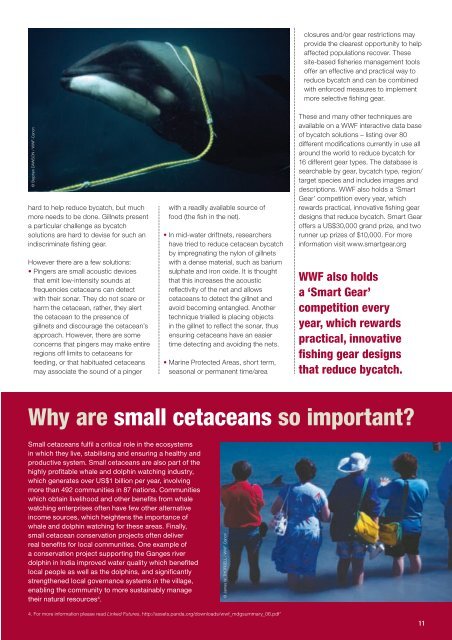Small Cetaceans: The Forgotten Whales
Small Cetaceans: The Forgotten Whales
Small Cetaceans: The Forgotten Whales
You also want an ePaper? Increase the reach of your titles
YUMPU automatically turns print PDFs into web optimized ePapers that Google loves.
© Stephen DAWSON / WWF-Canon<br />
hard to help reduce bycatch, but much<br />
more needs to be done. Gillnets present<br />
a particular challenge as bycatch<br />
solutions are hard to devise for such an<br />
indiscriminate fishing gear.<br />
However there are a few solutions:<br />
Pingers are small acoustic devices<br />
that emit low-intensity sounds at<br />
frequencies cetaceans can detect<br />
with their sonar. <strong>The</strong>y do not scare or<br />
harm the cetacean, rather, they alert<br />
the cetacean to the presence of<br />
gillnets and discourage the cetacean’s<br />
approach. However, there are some<br />
concerns that pingers may make entire<br />
regions off limits to cetaceans for<br />
feeding, or that habituated cetaceans<br />
may associate the sound of a pinger<br />
with a readily available source of<br />
food (the fish in the net).<br />
In mid-water driftnets, researchers<br />
have tried to reduce cetacean bycatch<br />
by impregnating the nylon of gillnets<br />
with a dense material, such as barium<br />
sulphate and iron oxide. It is thought<br />
that this increases the acoustic<br />
reflectivity of the net and allows<br />
cetaceans to detect the gillnet and<br />
avoid becoming entangled. Another<br />
technique trialled is placing objects<br />
in the gillnet to reflect the sonar, thus<br />
ensuring cetaceans have an easier<br />
time detecting and avoiding the nets.<br />
Marine Protected Areas, short term,<br />
seasonal or permanent time/area<br />
closures and/or gear restrictions may<br />
provide the clearest opportunity to help<br />
affected populations recover. <strong>The</strong>se<br />
site-based fisheries management tools<br />
offer an effective and practical way to<br />
reduce bycatch and can be combined<br />
with enforced measures to implement<br />
more selective fishing gear.<br />
<strong>The</strong>se and many other techniques are<br />
available on a WWF interactive data base<br />
of bycatch solutions – listing over 80<br />
different modifications currently in use all<br />
around the world to reduce bycatch for<br />
16 different gear types. <strong>The</strong> database is<br />
searchable by gear, bycatch type, region/<br />
target species and includes images and<br />
descriptions. WWF also holds a ‘Smart<br />
Gear’ competition every year, which<br />
rewards practical, innovative fishing gear<br />
designs that reduce bycatch. Smart Gear<br />
offers a US$30,000 grand prize, and two<br />
runner up prizes of $10,000. For more<br />
information visit www.smartgear.org<br />
WWF also holds<br />
a ‘Smart Gear’<br />
competition every<br />
year, which rewards<br />
practical, innovative<br />
fishing gear designs<br />
that reduce bycatch.<br />
Why are small cetaceans so important?<br />
<strong>Small</strong> cetaceans fulfil a critical role in the ecosystems<br />
in which they live, stabilising and ensuring a healthy and<br />
productive system. <strong>Small</strong> cetaceans are also part of the<br />
highly profitable whale and dolphin watching industry,<br />
which generates over US$1 billion per year, involving<br />
more than 492 communities in 87 nations. Communities<br />
which obtain livelihood and other benefits from whale<br />
watching enterprises often have few other alternative<br />
income sources, which heightens the importance of<br />
whale and dolphin watching for these areas. Finally,<br />
small cetacean conservation projects often deliver<br />
real benefits for local communities. One example of<br />
a conservation project supporting the Ganges river<br />
dolphin in India improved water quality which benefited<br />
local people as well as the dolphins, and significantly<br />
strengthened local governance systems in the village,<br />
enabling the community to more sustainably manage<br />
their natural resources 4 .<br />
© James W. THORSELL / WWF-Canon<br />
4. For more information please read Linked Futures, http://assets.panda.org/downloads/wwf_mdgsummary_06.pdf’<br />
11

















